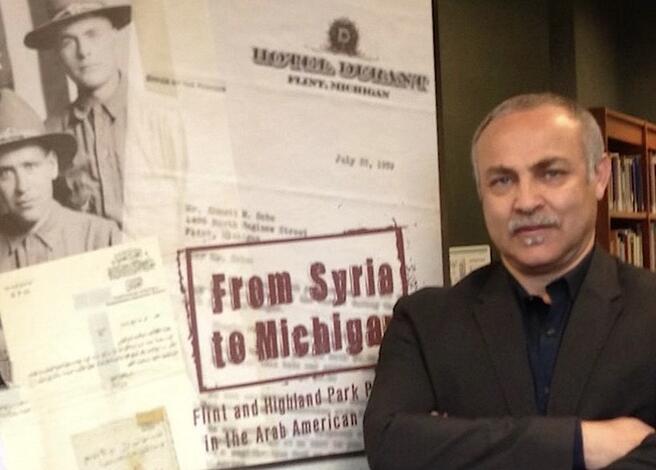Bawardi now serves as a board member for Washington Street Historical Society, focused on preserving the history of the Syrian and Lebanese populations who lived on Manhattan’s lower westside.
He worked with other society board members on planning a memorial to honor “the Poets of the Syrian Colony.” The Save Washington Street Historical Society recently secured a nearly $1.5 million Mellon Foundation grant for the art installation. He said ACCESS Dearborn also played an important role in helping write the grant and will be housing it.
The grant funds will be used to install a 3D art memorial celebrating Arab immigrant diaspora authors like Naimy, Rihani, an intellectual who reflected on American freedom and religious tolerance, and Kahlil Gibran, author of The Prophet, one of the best selling books in history. These authors were among the members of the famed Pen Bond in New York City. This group of 10 poets and writers revolutionized the standard Arabic language a century ago. Their poetry and prose continue to be an essential part of education across the Arab World and beyond.
“Visitors will learn about the Arab immigrant presence in Lower Manhattan a century ago, as well as the ideas of that community’s writers and their contribution to Arabic and English literature both then and now.”
The site of the future memorial, New York City’s Elizabeth H. Berger Plaza, lies immediately adjacent to the former Syrian Quarter near Washington Street — just steps away from where the immigrants disembarked at Battery Park starting in the 1880s.
French Moroccan artist Sara Ouhaddou’s proposal was selected after a years-long international selection process. There will be plantings of hardy shrubs and trees native to the Eastern Mediterranean. Quotations from Pen Bond authors will be set in stone, tile and stained glass. In addition to the decorative alphabet, the texts of quotations will be displayed in plaques along the park, written in standard Arabic script with English translation. A key to deciphering the geometric alphabet and their Arabic letters also will be provided.
Bawardi also will work with the Arab American Center for Culture and the Arts, a local literary group, on developing programming — like displays, workshops, readings and podcasts — to go with the monument completion in 2024.
Just like he’s done when creating first-year seminars on Ameen Rihani at UM-Dearborn and curating archival displays, Bawardi will utilize his archives to educate students and the public while commemorating the Arab Americans who played vital roles in the early 20th century.
“I want to remember and honor those pioneers who worked to preserve our mother tongue and Arab culture in the U.S., and to uphold their ancestral homelands’ quest for democracy and equality.” In the future, Bawardi hopes that regional repositories for the surviving documents — photos, oral histories, letters and more — are created and maintained.
Bawardi said he’s inspired by the “tireless work” of scholars like the late Arab American historian Alixa Naff, known as the mother of Arab American oral histories. Naff herself grew up in Michigan after her parents left the Ottoman province of Syria, now modern-day Lebanon. Naff’s family owned and managed a successful grocery story that they sold in 1949.
The Michigan-based convenience store owners may not be named in the memorial, but the families Bawardi spoke with over two decades ago — the ones who shared their stories and explained why they were in the grocery business — played an important role in this too. Bawardi said they are vital to the immigrant experience and much history would have been lost without the documents and knowledge they shared with him.
That brings us back to the question: “Why do Arabs own grocery stores?”
Bawardi found that grocery retail was a natural outcome of peddling door to door for many early Arab American pioneers. Owning a general store became economic and social anchors in their new lives. Later, when immigration restrictions were lifted in 1965 and larger numbers came as students or through family sponsorship, economic decline in the inner city offered the opportunity to provide a much needed service. Family ties, hard work and long hours did the rest. But there are aspects of this complex experience that defy binary black-white race relations. Arabs, Bawardi concluded, found “a haven from the glare of anglo-conformity” in Black communities.
“Arab Americans are among the few immigrant groups who have yet to write their story in their own voices based on first hand accounts,” he said. “Pioneering scholars of Arab American studies in the 1970s and 80s didn’t focus on the first 70 or so years of the Arab American experience, because most were not trained historians or keen on archival evidence. The problem persisted because newcomers to this area of research do not possess the requisite Arabic language skills. But through families and communities collectively sharing, we are working together to preserve these histories, take pride in them and educate others now and into the future.”
Article by Sarah Tuxbury.





